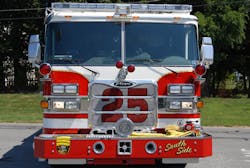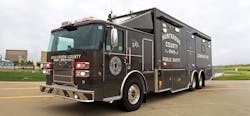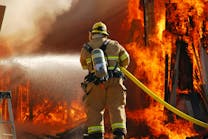During the 1940s, several manufacturers recognized that when World War II ended, there would be an unprecedented need for new fire apparatus in most communities. As most industrial capacity was focused on supplying armaments and supplies for the war effort, few apparatus were available for municipal departments. Companies like American and Ward LaFrance, Hahn, Maxim and Mack turned out hundreds of wartime apparatus to protect military bases both at home and abroad. When World War II ended, in September of 1945, the fire apparatus industry returned their efforts to peacetime production of new apparatus.
As a result of these influences several manufacturers produced a radically new style of apparatus to capture the market and to encourage municipalities to renew their aging apparatus fleets. American LaFrance introduced their 700 series units, which for the first time put the driver and officers’ seats ahead of the engine compartment. They built hundreds of these short wheelbase units in both open- and closed-cab configurations. This new design, together with those introduced by other builders, were truly “Concept Vehicles” in that they radically changed the overall design of apparatus being purchased and subsequently influenced the design of units for many years.
In 1984, the Young Fire Equipment Company built the first four-door cab pumper equipped with a raised roof, midship engine and crankshaft driven 1,250-gpm fire pump. This pumper was equipped with eight preconnected attack lines and was displayed at many fire shows through the year to introduce fire departments to another “Concept Vehicle” that once again changed the minds of many fire service leaders.
In 2007, Pierce Manufacturing introduced what I would consider another version of a “Concept Vehicle” with the unveiling of the Pierce Ultimate Configuration (PUC) pumper. Like some of the earlier concept apparatus, the PUC is offered with shorter wheelbases (as low as 172 inches) by incorporating the fire pump under the cab with a non-traditional pump panel location that saves on both weight and compartment space within the apparatus body. The PUC design has been well received with more than 450 units delivered since its introduction. Our Innovative Apparatus for October was found operating with the Monroe Fire Company in Cumberland County, PA. What set this unit apart from others is the well-executed plan to locate and mount hose, tools and appliances on their new Pierce Arrow XT PUC pumper.
Department Demographics
The Monroe Fire Company operates as Company 25 in Cumberland County and provides fire protection and emergency medical services (EMS) to the more than 5,500 people in a first due area of some 26.5 square miles. The volunteer fire company was founded in 1937 with its history dating back to as far as 1860. Today, the department is under the command of Chief David A. Heckert and operates from a single fire station located at 1225 Peffer Road in the Village of Churchtown. The fire company annually responds to more than 250 incidents in their first due area and other areas within Cumberland County.
Over the years the Monroe Fire Department has operated a unique fleet of apparatus, including several large capacity pumper tankers that could only be described as “massive.” One of the earliest units was a 1953 Reo/Luverne pumper that was modified by department members with the installation of a Harrisburg Blitz Box to provide four preconnected crosslay attack lines. In 1979, a Ford C model Grumman pumper was placed into service followed by a Mack R model canopy cab pumper tanker that carried 2,000 gallons of water on a tandem axle chassis. New engine apparatus were acquired in 1989 with the delivery of an Emergency One pumper on a Spartan Gladiator chassis equipped with a 2,000-gpm pump with a 1,000-gallon tank. This unit was replaced in 2001 with another Emergency One pumper equipped with CAFS and a 750-gallon tank. Tanker 25 received a new Emergency One tandem axle apparatus in 1996 and carried 3,000 gallons of water with a 500-gpm pump. In 1992, the department took delivery of a Ford F-450 chassis with Emergency One bodywork as Mini Pumper 25.
As the department has been able to provide for a 10-year replacement cycle for their front-line apparatus, the Monroe Fire Company has been able to provide their used apparatus to other departments while the units are still fairly new and in very good condition. Today, the fire company operates a 2010 Pierce Arrow XT pumper as Engine 25 and a 2006 International 4400 model chassis with a Four Guys stainless steel elliptical water tank. Tanker 25 is equipped with a 1,250-gpm pump and a 2,200-gallon water tank. Mini Pumper 25 is assigned a 2001 Ford F-550/Boise Mobile Equipment unit outfitted with a 750-gpm pump and a 250-gallon water tank with both Class A and Class B foam capabilities. Other units include a 2002 Ford brush truck, a 2005 Ford utility pick up, three chiefs’ vehicles and two Zodiac boats for water rescue.
Need To Replace Engine
When it came time to replace both Engine and Tanker 25, Chief Heckert stated that there was a concerted effort put forth to downsize the apparatus for several reasons. While most all of Company 25’s first-due area is rural, without benefit of hydrant protection, it was felt that the earlier apparatus had gotten too large and often had to make several maneuvers on the fire ground to achieve the desired position at the scene of the incident. Working with the department’s apparatus committee and Cyle Sheaffer from Glick Fire Equipment, Chief Heckert developed a set of technical specifications that outlined the important design requirements for the new apparatus. This allowed for the new Engine 25 to be shorter in wheelbase and overall length to the previous unit, while increasing its compartment space and fire attack capability.
The result of this process was the delivery earlier this year of a Pierce Arrow XT PUC pumper with a 67-inch cab and 10-inch raised roof. A Detroit Diesel Series 60 engine, rated at 515 horsepower, through an Allison Generation IV model EVS-4000 five-speed automatic transmission, powers this unit. The chassis is equipped with several safety components, including TAK 4 independent front suspension, side-roll protection together with electronic stability control.
Engine 25 is built with a wheelbase of 189.5 inches and an overall length of just 32 feet. The Arrow XT ac provides seating for six personnel with five seats equipped with hands-free self-contained breathing apparatus (SCBA) brackets. Each of the seating positions is provided with a wireless Fire Com headset. The interior of the cab is provided with an enclosed roll-up door EMS cabinet with Performance Advantage Company Pac Trac on the rear wall for secure mounting of forcible-entry hand tools. The apparatus body is 189 inches long with an overall height of 125 inches to the top of the vertical exhaust.
The front of the apparatus is equipped with an FDNY-style painted steel bumper designed to protect the front of the apparatus and the crew. The 22-inch extension is equipped with a Federal mechanical siren, electronic siren speaker and twin air horns. The right side of the bumper is notched for the 5-inch front suction intake with a 2.5-inch front bumper discharge located on the left side. This discharge is outfitted with a gated wye and is equipped with 150 feet of 1.75-inch hose for an attack line.
Emergency Warning Features & Safety Equipment
The apparatus warning-light package consists of a Whelen Freedom 88-inch long roof-mounted LED light bar with two Whelen LED lights located above the cab doors on each side of the unit. Cab-mounted front warning lights include four Whelen Super LED lights, twin pedestal-mounted Mars lights together with an LED-style Roto-Ray light. Body warning lights consist of Whelen Super LED lights along both sides and rear of the apparatus. Scene lighting is provided by a front-mounted cab Fire Research 750-watt Optimum light and Fire Research 150-watt HID recess-mounted cab lights. Two Fire Research Optimum lights are located on each side of the body with a Focus model 300-watt light recessed at the rear of the body under the hose bed area. In addition, a Willburt Night Scan light tower is mounted on the cab roof. These lights are powered by a Harrison 10-Kw hydraulic generator, which is mounted in front of the hose body.
A Safety Vision color back-up camera is provided at the right front side of the cab and at the rear body. The rear body is also equipped with red and yellow Chevron stripping and enclosed compartments to accommodate two 10-foot lengths of flexible suction hose together with a 10-foot folding, 14-foot roof and 24-foot extension ladders and several pike poles.
Vehicle Body Features
The body is fabricated from aluminum and is provided with nine enclosed lower body compartments and four upper body locker compartments. Amdor painted roll-up shutter doors protects the lower body compartments. The compartment layouts were determined by the fire department working with the local Pierce dealership. By using an assortment of slide trays, adjustable shelves and dividers, each compartment was designed to accommodate the type of equipment that would normally be needed to perform certain tasks. For example, the right side forward compartment carries salvage equipment, electrical cords, portable lighting and a Little Giant ladder, together with a unique pullout tray outfitted with small hand tools. The left front compartment contains the fire pump panel, nozzles, adapters and appliances for any type of water supply delivery.
The rear hose bed is equipped with 1,200 feet of 5-inch and 600 feet of 3-inch hose for supply and leader lines. Engine 25 carries two 200-foot, 1.75-inch attack lines in removable hose trays at the front of the body, together with a 300-foot pre-connected 1.75-inch attack line at the rear. A 200-foot pre-connected 2.5-inch line supplies a Task Force Blitz Fire monitor with a second 3- inch rear discharge available for other lines that may be needed.
The fire pump on this unit is a Pierce PUC design rated at 1,500 gpm, equipped with Hercules 140 cfm CAFS with a Husky 12 dual-agent foam system. The fire pump intakes consist of two 6-inch inlets and a 5-inch rear intake equipped with an auto-fill valve control. The left side pump panel is provided with two 2.5-inch discharges with both a 2.5-inch discharge and an LDH discharge controlled by an electric valve. A 3-inch discharge supplies a top-mounted Task Force monitor and is equipped with crank-style valve controls at both the pump panel and at the monitor. A 750-gallon water tank is provided together with two foam cells, one 50 gallon for Class A and 30-gallon Class B foam operations.
The Monroe Fire Company set out to design their apparatus to accommodate all of the needed hose, tools and equipment to operate while making the engine apparatus shorter and more maneuverable than previous units. Engine 25 is a great example of a department taking a “Concept Vehicle” and making it even better by planning the hose, tools and equipment layout on the apparatus. I would like to thank Chief David A. Heckert and President David D. Heckert who assisted with technical information on their new apparatus.
TOM SHAND is a 37-year veteran of the fire service having served with departments in Maryland, Pennsylvania and New York. He has worked in the fire apparatus industry since 1985, including 15 years with Saulsbury Fire Apparatus. He is a contributing editor to Fire Apparatus Journal and Firehouse Magazine and works with Mike Wilbur at Emergency Vehicle Response. He co-hosts the Apparatus Architects podcast with Wilbur, based on their column in Firehouse Magazine.









